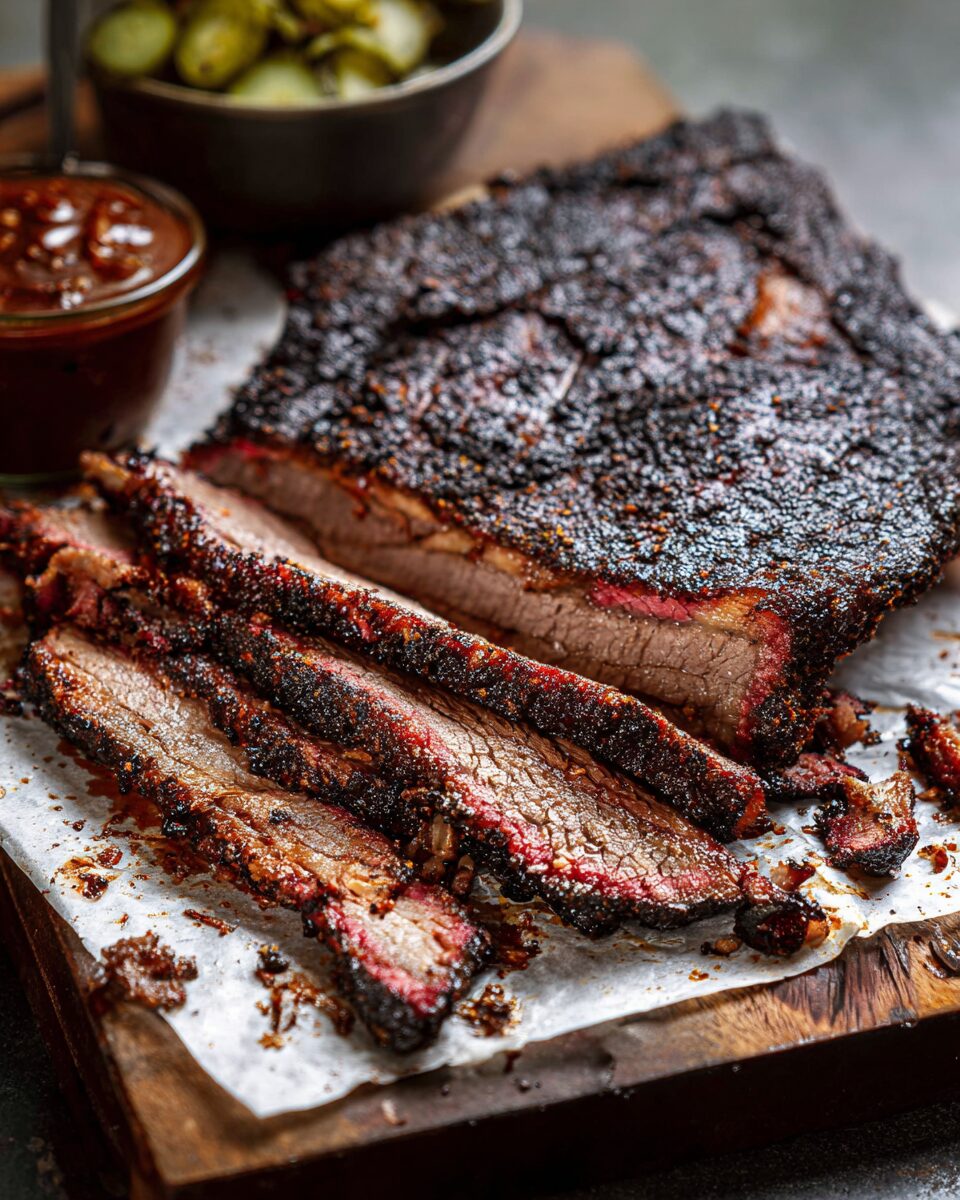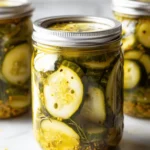The smoked brisket is a showstopper. Its rich, smoky aroma fills the air, setting the stage for a meal that is both comforting and indulgent. With a perfectly crisp outer bark and tender, juicy meat that practically melts in your mouth, every bite is a celebration of bold, smoky flavors.
Whether you’re serving it at a BBQ, a family gathering, or just enjoying a quiet meal at home, this smoked brisket brings people together. The low-and-slow cooking process creates a melt-in-your-mouth texture that’s nothing short of extraordinary, while the spices give it a flavorful kick. Serve it with classic sides like coleslaw, baked beans, and cornbread for a true southern-style feast.
Full Recipe:
-
1 whole beef brisket (about 5 pounds)
-
2 tablespoons olive oil
-
2 tablespoons brown sugar
-
2 tablespoons smoked paprika
-
1 tablespoon kosher salt
-
1 tablespoon black pepper
-
1 tablespoon garlic powder
-
1 tablespoon onion powder
-
1 teaspoon ground cumin
-
1 teaspoon chili powder
-
1/2 teaspoon cayenne pepper (optional)
-
1/2 cup apple cider vinegar
-
1 cup beef broth
-
Wood chips for smoking (hickory or oak)
Directions:
-
Preheat your smoker to 225°F (107°C) and prepare the wood chips by soaking them in water for about 30 minutes.
-
Rub the brisket all over with olive oil, then apply a generous layer of brown sugar, smoked paprika, salt, black pepper, garlic powder, onion powder, cumin, chili powder, and cayenne pepper. Let it sit at room temperature for about 30 minutes to allow the rub to set.
-
Place the brisket on the smoker rack and insert a meat thermometer into the thickest part of the meat. Close the smoker and maintain a steady 225°F.
-
Smoke the brisket for about 6-8 hours, or until the internal temperature reaches 195°F (90°C) for tender, fall-apart meat. You may need to replenish wood chips every hour to maintain a steady smoke.
-
Once the brisket reaches the desired temperature, remove it from the smoker and wrap it tightly in foil. Let it rest for at least 30 minutes to allow the juices to redistribute.
-
Slice the brisket against the grain and serve with your favorite barbecue sauce or sides.
Prep Time: 30 minutes | Cooking Time: 8 hours | Total Time: 8 hours 30 minutes
Kcal: 300 kcal (per serving) | Servings: 6 servings
History and Origin
Brisket has deep roots in various culinary traditions, but its place in American BBQ culture is particularly prominent. Originally, brisket was a cut of beef that didn’t get much love from cooks due to its toughness. However, over time, various cooking methods, particularly smoking, transformed this inexpensive cut into a coveted delicacy. The technique of smoking meats dates back to the indigenous people of the Americas, who would slow-cook meat over wood fires.
In Texas, where BBQ is a cultural cornerstone, the smoking of brisket became an art form. The region’s BBQ tradition is so iconic that it’s often referred to as “Texas-style brisket.” This style typically involves rubbing the meat with simple seasonings like salt and pepper, and then smoking it low and slow over hickory or oak wood to achieve that signature smoky flavor. Other BBQ regions, like Kansas City and Memphis, have their own variations of smoked brisket, often incorporating different sauces or spices, but the process remains largely the same: slow-cooking for hours until the meat is tender and infused with smoky goodness.
The popularity of smoked brisket has expanded beyond BBQ joints and home grills. It has found its place in restaurants, food trucks, and even fine dining establishments, proving that this humble cut of beef can be elevated to an extraordinary level.
Variations and Adaptations
While smoked brisket is traditionally associated with Texas BBQ, there are many regional variations and adaptations that bring unique flavors to the dish. In the Carolinas, for instance, BBQ brisket is often served with a tangy vinegar-based sauce that complements the smoky meat. This style of BBQ is known for its balance of smoky, tangy, and spicy flavors, offering a refreshing contrast to the richness of the brisket.
In Kansas City, a sweeter BBQ sauce might be used to glaze the brisket, resulting in a sticky, caramelized crust that adds depth and complexity. Kansas City BBQ is known for its bold, sweet sauces made from molasses or brown sugar, which blend wonderfully with the smoky beef.
In Jewish cuisine, brisket is often braised rather than smoked, and it plays a starring role in traditional dishes like “brisket with onions” or as a centerpiece during holiday feasts such as Passover. While not smoked in this case, the slow-cooked beef retains much of the tenderness and rich flavor that makes brisket so popular.
For those looking to get creative, smoked brisket can be used in various fusion dishes. You might find it shredded and added to tacos or quesadillas in Tex-Mex cuisine, or even served atop a pizza with a drizzle of barbecue sauce for a unique twist. The options are endless, and each variation brings out different aspects of the brisket’s flavor profile.
Nutritional Information
Smoked brisket, like most cuts of beef, is a source of high-quality protein and essential nutrients. It’s rich in B vitamins, particularly niacin, riboflavin, and B6, which support metabolism and energy production. Brisket is also an excellent source of iron, which helps with the transportation of oxygen throughout the body, and zinc, which plays a role in immune function and cell repair.
However, brisket is also a fatty cut of meat, so it can be higher in calories compared to leaner cuts. A typical serving of smoked brisket (about 4 ounces) contains approximately:
-
Calories: 300-350 kcal
-
Protein: 25-30 grams
-
Fat: 20-25 grams (with a significant portion coming from saturated fat)
-
Carbohydrates: 0 grams (Brisket contains no carbs, which makes it a good option for low-carb diets)
Despite the higher fat content, smoked brisket can be enjoyed in moderation as part of a balanced diet. If you’re looking for a leaner option, trimming the fat before cooking or opting for a leaner cut of beef can help reduce the overall fat intake.
Additionally, the spice rub used in smoking brisket (typically a mixture of salt, pepper, paprika, garlic powder, and other seasonings) provides small amounts of antioxidants and minerals, which can support overall health. The long smoking process also allows the flavors to concentrate, making each bite deeply satisfying.
Serving Suggestions and Pairings
Smoked brisket is a versatile dish that pairs well with a variety of sides and beverages. Classic accompaniments include:
-
Coleslaw: The creamy, tangy flavor of coleslaw provides a refreshing contrast to the rich and smoky brisket. The crunchiness of the cabbage adds texture, balancing the tenderness of the meat.
-
Cornbread: A warm, slightly sweet cornbread is a staple side dish in BBQ meals. It complements the savory brisket and soaks up any juices or sauce left on your plate.
-
Pickles: A side of tangy pickles can cut through the richness of the brisket and add a welcome burst of acidity.
-
Grilled Vegetables: Smoky grilled vegetables, such as bell peppers, onions, and zucchini, make a great side dish that echoes the flavors of the brisket while offering a lighter contrast.
When it comes to beverages, smoked brisket pairs wonderfully with bold drinks. You might enjoy it with a glass of full-bodied red wine, like Cabernet Sauvignon or Malbec, which has enough structure to stand up to the richness of the meat. For beer lovers, a dark stout or porter can be an excellent choice, with the roasted flavors of the beer complementing the smoky meat. For non-alcoholic options, iced tea or a tangy lemonade would be refreshing and help cleanse the palate between bites.
Tips and Tricks for Success
Smoking brisket requires patience, but with the right techniques, the results can be extraordinary. Here are a few tips to ensure your smoked brisket turns out perfectly every time:
-
Low and Slow: The key to a tender brisket is cooking it at a low temperature for a long period. Aim for a smoker temperature of 225°F (107°C) and be patient—it may take anywhere from 6 to 10 hours, depending on the size of the brisket.
-
Use a Meat Thermometer: To get the perfect level of tenderness, it’s essential to monitor the internal temperature. The brisket should reach an internal temperature of 195°F (90°C) for optimal tenderness.
-
Rest the Meat: Once the brisket is done smoking, let it rest for at least 30 minutes before slicing. This allows the juices to redistribute throughout the meat, ensuring each slice is moist and flavorful.
-
Fat Cap: Brisket has a layer of fat known as the “fat cap.” Some people prefer to leave it on, as it helps to keep the meat moist during the smoking process. Others choose to trim it for a leaner result. Either way, the fat adds flavor, so don’t skip this step.
Potential Health Benefits
While brisket is a rich source of protein, iron, and B vitamins, there are also some potential health benefits to consider. The protein content in brisket is vital for muscle repair and overall body maintenance, and the iron it provides can help prevent iron-deficiency anemia. The zinc in brisket also supports a healthy immune system and wound healing.
That being said, the high fat content in brisket means it should be enjoyed in moderation, especially for those watching their calorie intake or managing cholesterol levels. Opting for smaller portions and pairing the brisket with fiber-rich sides like vegetables and salads can make for a more balanced meal.
Conclusion
Smoked brisket is a true showstopper—a dish that’s both hearty and comforting, with a rich history and deep cultural roots. Whether you’re smoking it for a family meal or a special occasion, the process of slow-smoking the beef creates a tender, flavorful dish that’s sure to impress. By pairing it with classic sides and beverages, and following a few expert tips, you can ensure your smoked brisket is nothing short of spectacular. So fire up the smoker, gather your loved ones, and enjoy the delicious results of this timeless BBQ favorite.





